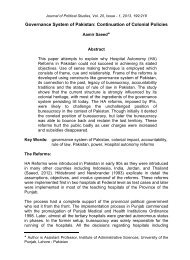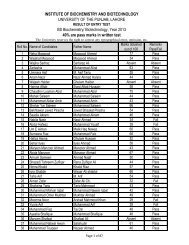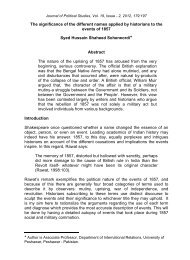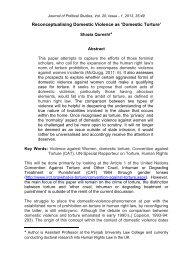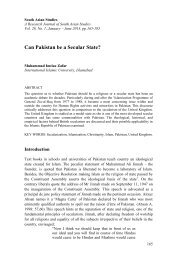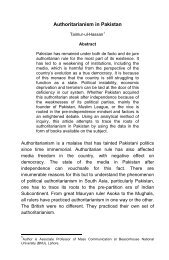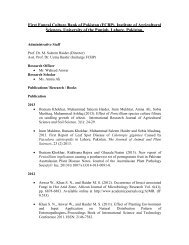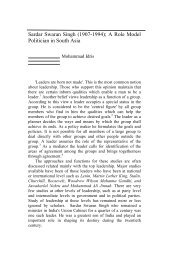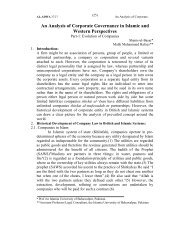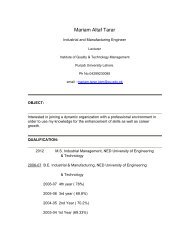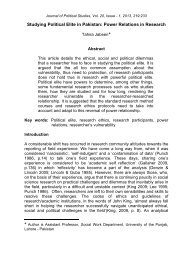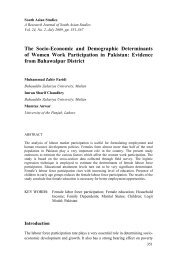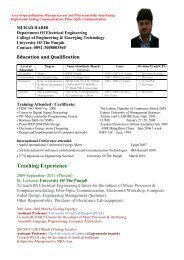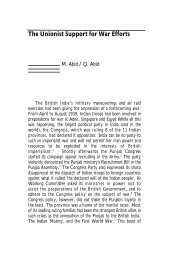pakistan geographical review 1954 - University of the Punjab
pakistan geographical review 1954 - University of the Punjab
pakistan geographical review 1954 - University of the Punjab
Create successful ePaper yourself
Turn your PDF publications into a flip-book with our unique Google optimized e-Paper software.
East is passing through a transitional period <strong>of</strong> industrial development,<br />
Cottage Industry is being replaced by factory industry with <strong>the</strong> consequent<br />
worsening <strong>of</strong> labour conditions. In spite <strong>of</strong> <strong>the</strong> pigment state <strong>of</strong> affairs<br />
Cottage industry can afford to survive due to those very facts which hinder<br />
<strong>the</strong> development <strong>of</strong> factory industry.<br />
At present cottage industries are:-<br />
(1) Textile goods.<br />
(2) Metal wor k.<br />
(3) Lea<strong>the</strong>r piece goods.<br />
(4) Wood work (sports goods etc.)<br />
Textile goods.<br />
Textiles consist <strong>of</strong> carpets <strong>of</strong> exquisite designs, fine cloth both cotton<br />
and woollen woven with gold and silver issues and a la.rge quantity <strong>of</strong> coars~<br />
cloth woven in hand looms after native country styles and demand.<br />
Carpet industry is <strong>of</strong> world wide fame in Iran. They are used for<br />
wall decoration and covering <strong>of</strong> Divans etc. Turkey, Iraq, Afghanistan and<br />
West <strong>Punjab</strong> started carpet making but instead <strong>of</strong> silk and cotton; wool and<br />
cotton fibres are used hence this stuff is no match for persian carpets.<br />
Afghan and Arabian rugs are woven wollen materials stripped in various<br />
colours. West Pakistan is noted for Kbaddi cloth <strong>of</strong> a great variety quality<br />
and being improved to a greater extent.<br />
Ano<strong>the</strong>r aspect <strong>of</strong> textile craftsmanship is <strong>the</strong> needlework and<br />
embroidary lace making and drawn thread work on silk and linn en r-equiring<br />
great skill prepared and sold to travellers and pilgrims. Important centres<br />
are Nazareth, Beirut, Aleppo and Damascus, where population is great<br />
and means <strong>of</strong> subsistence restricted.<br />
Metal Work.<br />
Based upon <strong>the</strong> small quantities <strong>of</strong> various metals like copper silver<br />
and gold, metal work in <strong>the</strong> Middle East is as ancient as her civilization.<br />
Copper and iron are smelted in small ovens in private shops and gold and<br />
silver inlay or die work is done. During Middle Ages Damascus steel inlay<br />
work had acquired a work reputatat io n. Partly because small mines have<br />
been exhausted and partly due. to <strong>the</strong> decreasing demand for fancy articles<br />
this industry is dying out. According to <strong>the</strong> present trends small iron and



